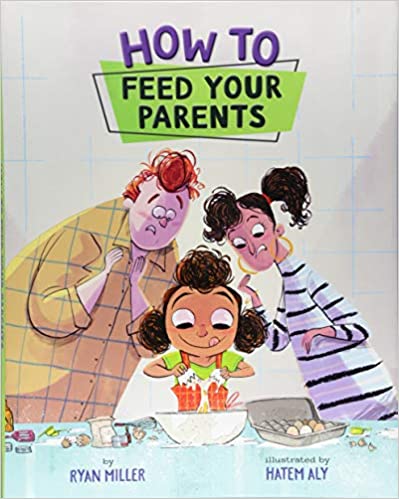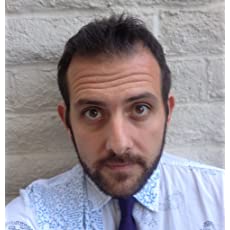Day jobs can be essential, especially for writers starting out. Sometimes those jobs can feel like a drain–of energy, of creativity, of joy. But often, skills you develop on the job can actually help with your writing. This series, comprised of interviews and posts from authors for children, focuses on how non-writing work has helped writers with their craft. We hope you might glean some craft tidbits from their experiences and that you might look for how your other interests enrich your writing. –KidLit Craft
by Ryan Miller
When I was 4, I told my mom I wanted to be a journalist.
I didn’t know it at the time, but she immediately imagined me in a flak jacket, my every report nearly drowned out by rattling gunfire and punctuated by the occasional deep, percussive whump of a nearby explosion.
She was worried.
I, however, was picturing myself as more of a naturalist journalist observing sea urchins and fruit bats and tiger salamanders, then writing about them and maybe visiting a late-night talk show host with a small, exotic, and camera-friendly menagerie.
Ultimately, my career path led me somewhere in the middle: newspapers.
As a reporter and editor, I encountered a fair amount of wildlife—animal and human—over the years. And council meetings may not have been deadly, but the rat-a-tat of public comment periods in the towns and small cities that make up California’s Central Coast sometimes made it feel awfully similar to a war zone.
My career in journalism began at my college radio station. Writing on-air news briefs to read between Simon and Garfunkel’s purest harmonies led to print articles for the school paper housed next door. I was then able to get a paying job at my college paper, followed by an internship at a small local newspaper my senior year. From there, I worked my way from arts editor to managing editor to executive editor. Fifteen years later, I was overseeing a staff of reporters, editors, photographers, and more at two newspapers: the Sun and New Times.
At the time I left, I was seeking to move with my wife and children back to my hometown, as well as return to my roots in a more metaphoric sense. I wanted to take everything I’d learned over the past couple of decades and write a children’s book. Several of them, actually.

My first successful pitch was to Sterling Children’s Books, which ultimately published How to Feed Your Parents in August 2018. As much as I’d like to say the muses delivered the story about a would-be epicurean girl with ultra-picky parents straight to my brain, it was actually the result of multiple lessons I shamelessly ripped from my time as a reporter. Namely:
1. Make Every Word Count
A popular journalistic writing style is the “inverted pyramid,” which puts the foundation of the story at the top, then adds in decreasingly important details. The reasoning behind this is simple: Attention spans are short. You want to give readers what they need—the who, what, when, where, and why—as quickly as possible, so they can be spoon-fed the most important info before they wander off to the comics page or crossword puzzle.
But that’s so boring! Fortunately, there is a counter-style, which we employed at the papers where I worked. It encourages writers to create stories so readable, no one would want to put them down before the end. Each sentence should be important, never giving someone an excuse to wonder what else is going on apart from the story. Every line should be fun or funny or exciting or surprising. At the very least, it should move the story along.
2. Use Your Senses
Prior to studying journalism at Cal Poly, San Luis Obispo, I spent my childhood days on marathon reading sessions, visits to local libraries, and filling journals with notes on neighborhood birdsongs and the daily changes to a rotting banana I kept in a bowl for far longer than I should have. Every nature book I read emphasized the importance of engaging the senses and recording the sights, sounds, and smells associated with any subject. So I did.
Even if you’re completely inventing a tale, it’s important to ground relatable details in reality. My journalism professors echoed those nature books I read in my youth, exhorting up-and-coming reporters to tap into more than just accurate quotes to make their stories come alive. Little details matter: the defendant’s mussed hair, the smell of someone’s garlic-heavy lunch in a small courtroom, the efficient clatter of a stenographer. Or it could be the smudge of grass and dirt on the quarterback’s elbow, the fans whose sweat cut clear lines in the paint on their faces, the clouds of moths beating the buzzing lights illuminating the field.
For my book, it was the spices in each dish, the warmth of a meal straight from the oven. I wanted readers to sniff the air around them, to feel their mouths start to water.
3. Trust Your Editors
I’ve come to the realization that writers are an odd mix of unabashed confidence (people will want to pay to read what I write) and crippling doubt (people will hate what I write).
The confident half of that Jekyll/Hyde-type personality split can be particularly troublesome. It’s the side that basks in the perfection of a final draft—and balks at anyone who would dare to trim a phrase or cut a word. Good editors (trusted beta readers and significant others included) know what works and what doesn’t. It’s important to let go of a paragraph that’s just not fitting in right, even if you think it’s the best thing you’ve ever written.
Trust me. As an editor, I wielded a red pen with what my reporters would surely say was a merciless efficiency. We had a finite number of column inches each issue, so sometimes something had to go.
An outside eye can—and almost always will—make your writing better: tighter, livelier, and more readable.
4. Pay Attention to the Bigger Story
This is more of an industry tip than a writing one, but it’s still important.
Any news story worth a read should not merely report on what happened, but should also put it in context. Similarly, kid lit writers must pay attention to not only their own book, but the larger market and reading public. You may have a fun vampire story going, but this is a post-Twilight world. That’s not to say your take on fangs is an impossible dream, but you’ve certainly got an uphill undead battle on your hands.
Look at the big picture: What’s selling now? What is the agency or publishing house you’re pitching putting out next season? What makes your book stand out?
I thoroughly researched my eventual editor prior to pitching How to Feed Your Parents, seeking info on what she liked to read, what she had previously edited, what she told industry publications she was looking for, and more. I didn’t write a book just for her, of course, but I did focus on a manuscript I thought she would love, as well as hone my pitch to catch her eye.
Set Your Writing Apart
Readers today are literally overwhelmed with options. That means writers who want their work to reach an audience have to work extra hard to not just stand out, but to keep the attention of anyone who gives their first lines a glance. Following these four tips stolen from the world of journalism—be highly selective with your words, be vivid and original in your descriptions, trust your collaborators, and keep your eyes open to what’s happening in the world around you—can go a long way toward setting your writing apart.

Ryan Miller is author of How to Feed Your Parents and works from home as the copy manager for a medical marketing firm. He is working on a new picture book, as well as a middle grade book on bees and puberty. Follow him on Instagram or Twitter (@jesteram), or visit standingintheshallows.com.
Check out our other Day Job Connection posts:
Aimee Lucido, Computer Programmer
Gregg Millman, TV and Screenwriter

COMMENTs:
0